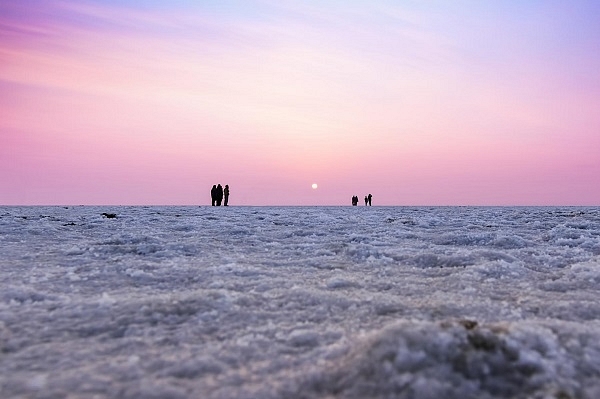News Brief
Vibrant Gujarat: In Tourism Ministry Webinar, Spectacle Of Salt Desert Unfolds In The Virtual World
- The webinar, which beamed the message ‘Kutch nahi Dekha toh Kuch nahi Dekha’, focussed on the resilient spirit of the people of Kutch to fight natural calamities, and their dynamic culture and civilisation.

Salt desert in the Rann of Kutch.
Defining India in the most dramatic manner, a virtual event unfolded the spectacle of salt deserts, mangroves and the resilient spirit of the people of Kutch with their skills to adapt to the extreme climate of the region, the participants of a Dekho Apna Desh webinar.
As part of the Ek Bharat Shreshtha Bharat, the Dekho Apna Desh webinar series showcased the history, culture, crafts and textile heritage of India’s largest district — Kutch in Gujarat — under the title of of The Tenacity of Survival: Inspirational story of Kutch.
Displaying the message of Kutch that “Kutch nahi Dekha toh Kuch nahi Dekha”, the webinar organised by Tourism Ministry focussed on the resilient spirit of the people of Kutch to fight natural calamities, the skills that form the report card of the continuous dynamics defining Indian civilisation.
The session was moderated by Rupinder Brar, Additional Director-General of the Ministry and was presented by Navina Jafa, Director, Indian Cultural Heritage Research.
Jafa through her powerful narration skills, presented the contrasting geographical features of Kutch, which is a land of salt desert, grasslands and mangroves.
Interestingly, the mangroves here are known for an amazing phenomenon of being the world’s only Inland Mangrove.
The Rann of Kutch alone produces three-fourth of the total salt supply of India.
Stakeholders were also told that the place is also home to the Kharai breed of camel, which has the special ability to survive on both dry land as well as in saline water.
They can even swim in seawater and feed on saline water and plants.
They are well-adapted to the extreme climate of the desert and high salinity of water.
The key highlights of the presentation were a virtual visit to the community of Ajrakh traditional block printers.
Ajrakh is one of the oldest types of block printing on textiles still practised in parts of Gujarat and Rajasthan.
Textiles printed in this style are hand-printed using natural dyes on both sides by a laborious and long process of resist printing (a method of printing in which designated areas in the pattern are treated to resist penetration by the dye).
The webinar then took the participants visit to Bannithe Salt Desert in Kutch, where the work of three major indigenous communities engaged in pottery, embroidery and leather work was showcased.
Ms. Jafa also spoke about the monastery of the ear torn ascetics (the siddhi siddhant sect) and the langar (Community kitchen) run by the monastery.
The presentation also covered the coastal town of Mandavi, where regional Sufi beliefs guide traditional boat builders on the Arabian Sea.
The other salient attractions of Kutch showcased in the webinar included Dholavira, fossil park, salt desert of Arabian sea, Kala Dungar, Guru Gorkanath Temple, Narayan Sarovar Temple, Lakhport Fort and Port and Surhando, which is a unique peacock-shaped instrument that plays melodious music.
Dholavira is a UNESCO World Heritage site and the second largest Harappan site located in India.
It is indeed a marvellous example of town-planning and architecture.
Two distinctive dance forms — Thali and Toofaan — were also showcased in the event.
While Thaali dance is a balancing dance performed to commemorate the celebrations of marriage and child birth, Toofaan is a famous wild dance of the ocean also known as “Samundar ki Masti”.
Dhordo is a village in Bhuj taluka of Kutch district of Gujarat. The ecosystem of this place is not conducive for any activity other than tourism like.
The Rann Utsav, which is annually organised from November to March, has become the main driver for tourism in Gujarat.
This transformation of the most challenging Dhordo White Rann to the most happening tourist destination of Gujarat has led to many temporary and permanent accommodation structures in and around Dhordo.
Sheer human grit, imagination and enterprise have transformed a harsh and unusual terrain in to an engine of socio economic and cultural vibrancy, bringing to its people a sense of self-reliance and pride.
The most popular of them all is the Rann Utsav Tent City organised with the support of Gujarat Tourism.
Rann Festival held every year is celebrated from December to February.
Bhuj city has been converted into a Tent City with basic amenities. The festival has attractions such as BSF Band, Hot Air Ballooning activities, a cultural fiesta of folk music and dance, shopping and tasting of traditional cuisines.
An itinerary for 3-4 days and 7-8 days was shared for capturing the real spirit of Kutch.
The itinerary aimed at guiding tourists travelling to Kutch, and giving them a bird’s eye view of things, locations, tourist sites, culture, traditions, textiles, block printing, musical instruments, marketplaces, village tours and dance forms.
Bhuj is well-connected by road from its neighbouring cities in Gujarat, and has good rail connectivity from various parts of the country, especially from Delhi and Mumbai and is also accessible by air from the Rudra Mata Airport.
The webinar sessions are now available here and also on all social media handles of the Ministry of Tourism, Government of India.
Introducing ElectionsHQ + 50 Ground Reports Project
The 2024 elections might seem easy to guess, but there are some important questions that shouldn't be missed.
Do freebies still sway voters? Do people prioritise infrastructure when voting? How will Punjab vote?
The answers to these questions provide great insights into where we, as a country, are headed in the years to come.
Swarajya is starting a project with an aim to do 50 solid ground stories and a smart commentary service on WhatsApp, a one-of-a-kind. We'd love your support during this election season.
Click below to contribute.
Latest